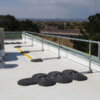Fall Protection for the Telecom Industry

Have you ever wondered how that 5G ultrawide internet gets to your phone? Antennas, of course. But where are the antennas placed? Many of them are placed on someone’s roof.
Leasing rooftops for equipment is the way of the future.
I am noticing a trend where telecommunication companies are seeking out rooftops available for lease to deploy their antennas. The telecommunications industry encompasses many sectors like radio, television broadcasting, cable, internet, and wireless phone carriers.
In this article, I’ll cover the primary concerns for fall hazards on leased rooftops. Then, I’ll let you know what OSHA says you need to do about it, even when the rooftop isn’t yours. Finally, I’ll walk through a real example of a rooftop survey and the fall protection you will need to make it OSHA compliant.
Fall Safety for Telecommunications on Leased Rooftops
Rooftops allow companies like AT&T, Verizon Wireless and T-Mobile to expand their coverage without investing money into infrastructure. Additionally, rooftops have no interference with the coverage, like walls or ceilings. It’s also a popular way for small business owners to make some extra cash.
So, who is responsible for protecting workers that maintain this equipment? Is it the building owner or the company leasing the rooftop?
No matter the situation, the company that sends the person to the roof is responsible for the worker, even if that person is a contractor.
Since you are ultimately responsible, how do you deploy fall protection measures on someone else's building? You can't go drilling holes into someone else's roofs.
The company who owns the building doesn’t want their roof damaged any more than necessary, potentially compromising the building or their warranty. So, as the lessee, you want to find a solution that protects your people while not damaging the landlord’s property.
So, here’s what you can do.
Fall Hazard Concerns and Their Solutions

First things first, you’ll want to perform a fall hazard survey for each location. It’s important that you do this every time because each roof will have its own concerns.
While you do this survey, here are 4 primary hazards to look out for.
Rooftop Access Points
The primary hazard in a fall hazard survey is the access point. The user is exposed to a fall at least two separate times: once getting on the roof and once more when they need to get down. This is also the closest you can get to a fall hazard as you are literally stepping over an edge for access.
Access points can be an access hatch, exterior ladder, or a penthouse stairway.
Rooftop hatches are required to have a hatch guardrail on all exposed sides, except the entrance. At the entrance, you need to have a self-closing gate or an offset.
An exterior ladder is best served by having a ladder guardrail on each exposed side with a self-closing safety gate.
Penthouse stairways are the safest means of gaining access to a roof when possible. No roof edges to climb over. However, once you step out onto the roof, any nearby roof edges need to be protected by a guardrail.
Rooftop Edges
The most common fall hazard to focus on a rooftop is the roof edge.
It’s easy to focus on the roof edges where mechanical equipment and antennas are placed nearby. Don’t forget to include anywhere a worker walks on the roof.
But how close do you have to be to the roof edge to be a concern?
If the work is temporary and infrequent, then fall protection is only needed if you are within 15 feet of the roof edge. A lot of rooftop work will fall under this caveat. If not, then you can use a rooftop warning line system at 15 feet to help save on cost.
If fall protection is required, then we advise that you use a non-penetrating guardrail system.
Rooftop Walking Paths
Falls from height are not the only concerns when walking on a rooftop. When you have mechanical equipment or antennas on a rooftop, you’ll also have conduit and other stringers that workers will have to step over.
Though there isn’t a compliance element to clear walking paths, they are important to prevent accidents. Oftentimes, contractors are on the roof with tools or equipment to complete the job. When carrying something that is heavy or awkward, people start to drag their feet.
Dragged feet + cable tray = face plant.
We can avoid this by providing an appropriate rooftop crossover platform where necessary.
Rooftop Skylights
One of the more dangerously forgotten rooftop hazards is a skylight. They are easy to overlook because you don’t see an edge. However, skylights are not typically designed to prevent a worker from crashing through them in an accident.
And it does happen, even to the best of us.
OSHA requires that all rooftop holes are protected by guardrails, covers, or personal fall protection systems. The most cost-effective way to protect a skylight is by using a skylight screen. Skylights screens are not just cost effective, they are also safer than using a personal fall protection system because no user interaction is required.
An Example Audit of a Telecommunications Leased Rooftop
Let’s examine a rooftop together.
In this fall hazard survey, we will focus on the cell antennas and equipment shelters where the contractors would be working.
I marked the areas of concerns with numbers in the image above to correspond to the numbers below.
- The primary hazard in a fall hazard survey is the access point. In this case, there is a hatch in the middle of the roof. While a standard roof hatch guardrail would work, we want to protect the workers from the fall hazard while protecting the roof. So, a non-penetrating roof hatch guardrail is the solution here.
- There are 3 areas of this roof where workers will be near a roof edge. Permanent, non-penetrating railing is the best option for this scenario. Kee Guard is simple to install and doesn’t require any specialized labor.
- The last hazard in this scenario is trip hazards. In this case, I noted two trip hazards where the cable trays obstruct the walking path. Non-penetrating crossover stairs are the solution here.
It’s that simple. This took less than 10 minutes to complete from my office using satellite imagery. There may be unknown obstacles that can be easily discovered in a conversation with someone who knows the facility.
Protect Your Leased Rooftops
We can help you protect your workers on leased rooftops with solutions your landlords will be thankful for. If you change locations or shut one down, you can either sell the fall protection to your landlord or take them with you to the new location.
Reach out today to have our team start your free remote fall hazard survey.




